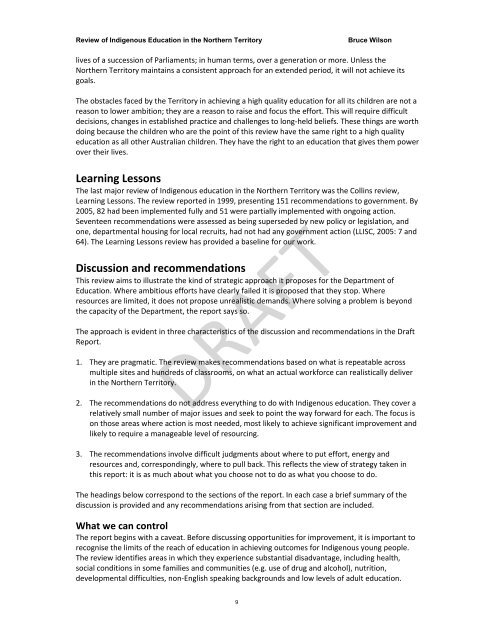Indigenous-Education-Review_DRAFT
Indigenous-Education-Review_DRAFT
Indigenous-Education-Review_DRAFT
You also want an ePaper? Increase the reach of your titles
YUMPU automatically turns print PDFs into web optimized ePapers that Google loves.
<strong>Review</strong> of <strong>Indigenous</strong> <strong>Education</strong> in the Northern Territory<br />
Bruce Wilson<br />
lives of a succession of Parliaments; in human terms, over a generation or more. Unless the<br />
Northern Territory maintains a consistent approach for an extended period, it will not achieve its<br />
goals.<br />
The obstacles faced by the Territory in achieving a high quality education for all its children are not a<br />
reason to lower ambition; they are a reason to raise and focus the effort. This will require difficult<br />
decisions, changes in established practice and challenges to long‐held beliefs. These things are worth<br />
doing because the children who are the point of this review have the same right to a high quality<br />
education as all other Australian children. They have the right to an education that gives them power<br />
over their lives.<br />
Learning Lessons<br />
The last major review of <strong>Indigenous</strong> education in the Northern Territory was the Collins review,<br />
Learning Lessons. The review reported in 1999, presenting 151 recommendations to government. By<br />
2005, 82 had been implemented fully and 51 were partially implemented with ongoing action.<br />
Seventeen recommendations were assessed as being superseded by new policy or legislation, and<br />
one, departmental housing for local recruits, had not had any government action (LLISC, 2005: 7 and<br />
64). The Learning Lessons review has provided a baseline for our work.<br />
Discussion and recommendations<br />
This review aims to illustrate the kind of strategic approach it proposes for the Department of<br />
<strong>Education</strong>. Where ambitious efforts have clearly failed it is proposed that they stop. Where<br />
resources are limited, it does not propose unrealistic demands. Where solving a problem is beyond<br />
the capacity of the Department, the report says so.<br />
The approach is evident in three characteristics of the discussion and recommendations in the Draft<br />
Report.<br />
1. They are pragmatic. The review makes recommendations based on what is repeatable across<br />
multiple sites and hundreds of classrooms, on what an actual workforce can realistically deliver<br />
in the Northern Territory.<br />
<strong>DRAFT</strong><br />
2. The recommendations do not address everything to do with <strong>Indigenous</strong> education. They cover a<br />
relatively small number of major issues and seek to point the way forward for each. The focus is<br />
on those areas where action is most needed, most likely to achieve significant improvement and<br />
likely to require a manageable level of resourcing.<br />
3. The recommendations involve difficult judgments about where to put effort, energy and<br />
resources and, correspondingly, where to pull back. This reflects the view of strategy taken in<br />
this report: it is as much about what you choose not to do as what you choose to do.<br />
The headings below correspond to the sections of the report. In each case a brief summary of the<br />
discussion is provided and any recommendations arising from that section are included.<br />
What we can control<br />
The report begins with a caveat. Before discussing opportunities for improvement, it is important to<br />
recognise the limits of the reach of education in achieving outcomes for <strong>Indigenous</strong> young people.<br />
The review identifies areas in which they experience substantial disadvantage, including health,<br />
social conditions in some families and communities (e.g. use of drug and alcohol), nutrition,<br />
developmental difficulties, non‐English speaking backgrounds and low levels of adult education.<br />
9


